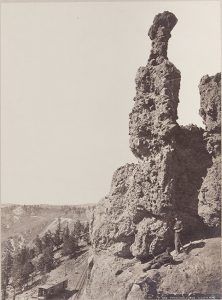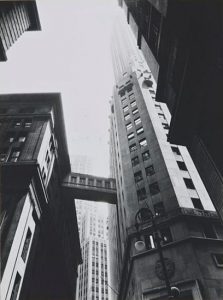 Abbott, Berenice (1898 – 1991), Canyon Stone and William, 1936, gelatin silver print. Middlebury College Museum of Art. Gift of Mr. and Mrs. Frederick W. Lapham III, 1984.030. Berenice Abbott/Getty Images Abbott, Berenice (1898 – 1991), Canyon Stone and William, 1936, gelatin silver print. Middlebury College Museum of Art. Gift of Mr. and Mrs. Frederick W. Lapham III, 1984.030. Berenice Abbott/Getty Images |
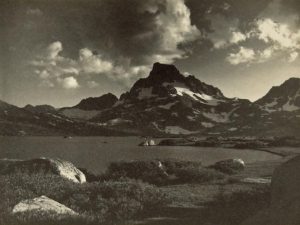 Adams, Ansel (1902-1984), Banner Peak – Thousand Island Lake, from Parmelian Prints of the High Sierras, 1927, gelatin silver print. Middlebury College Museum of Art. Purchase with funds provided by the Christian A. Johnson Memorial Art Acquisition Fund and the Walter Cerf Art Fund, 2016.001.12. Reproduced with permission from The Ansel Adams Publishing Rights Trust. All rights reserved. Adams, Ansel (1902-1984), Banner Peak – Thousand Island Lake, from Parmelian Prints of the High Sierras, 1927, gelatin silver print. Middlebury College Museum of Art. Purchase with funds provided by the Christian A. Johnson Memorial Art Acquisition Fund and the Walter Cerf Art Fund, 2016.001.12. Reproduced with permission from The Ansel Adams Publishing Rights Trust. All rights reserved. |
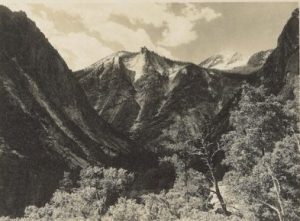 Adams, Ansel (1902-1984), Lower Paradise Valley, from Parmelian Prints of the High Sierras, 1927, gelatin silver print. Middlebury College Museum of Art. Purchase with funds provided by the Christian A. Johnson Memorial Art Acquisition Fund and the Walter Cerf Art Fund, 2016.001.17. Reproduced with permission from The Ansel Adams Publishing Rights Trust. All rights reserved. Adams, Ansel (1902-1984), Lower Paradise Valley, from Parmelian Prints of the High Sierras, 1927, gelatin silver print. Middlebury College Museum of Art. Purchase with funds provided by the Christian A. Johnson Memorial Art Acquisition Fund and the Walter Cerf Art Fund, 2016.001.17. Reproduced with permission from The Ansel Adams Publishing Rights Trust. All rights reserved. |
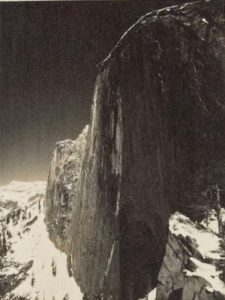 Adams, Ansel (1902-1984), Monolith – The Face of Half Dome, from Parmelian Prints of the High Sierras, 1927, gelatin silver print. Middlebury College Museum of Art. Purchase with funds provided by the Christian A. Johnson Memorial Art Acquisition Fund and the Walter Cerf Art Fund, 2016.001.03. Reproduced with permission from The Ansel Adams Publishing Rights Trust. All rights reserved. Adams, Ansel (1902-1984), Monolith – The Face of Half Dome, from Parmelian Prints of the High Sierras, 1927, gelatin silver print. Middlebury College Museum of Art. Purchase with funds provided by the Christian A. Johnson Memorial Art Acquisition Fund and the Walter Cerf Art Fund, 2016.001.03. Reproduced with permission from The Ansel Adams Publishing Rights Trust. All rights reserved. |
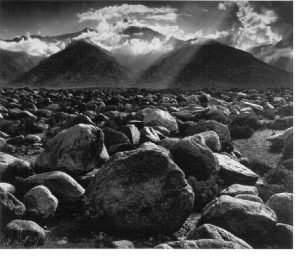 Ansel Adams, Mount Williamson, Sierra Nevada, from Manzanar, California, 1944, gelatin silver print. Middlebury College Museum of Art. Purchase with funds provided by the Electra Havemeyer Webb Memorial Fund and the Christian A. Johnson Memorial Art Acquisition Fund, 2003.006. Reproduced with permission from The Ansel Adams Publishing Rights Trust. All rights reserved. Ansel Adams, Mount Williamson, Sierra Nevada, from Manzanar, California, 1944, gelatin silver print. Middlebury College Museum of Art. Purchase with funds provided by the Electra Havemeyer Webb Memorial Fund and the Christian A. Johnson Memorial Art Acquisition Fund, 2003.006. Reproduced with permission from The Ansel Adams Publishing Rights Trust. All rights reserved. |
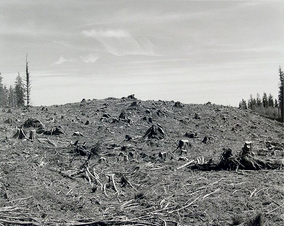 Adams, Robert (1937 – ), Clatsop County, Oregon, from Turning Back, A Photographic Journal of Re-exploration, 1999-2003, gelatin silver print. Middlebury College Museum of Art. Purchase with funds provided by Kathy and Richard S. Fuld, Jr. 2006.026.091. © Robert Adams, courtesy Fraenkel Gallery, San Francisco Adams, Robert (1937 – ), Clatsop County, Oregon, from Turning Back, A Photographic Journal of Re-exploration, 1999-2003, gelatin silver print. Middlebury College Museum of Art. Purchase with funds provided by Kathy and Richard S. Fuld, Jr. 2006.026.091. © Robert Adams, courtesy Fraenkel Gallery, San Francisco |
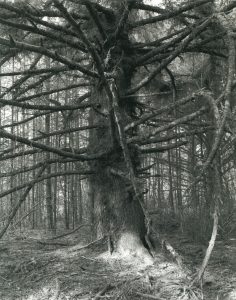 Adams, Robert (1937 – ), Sitka Spruce, Cape Blanco State Park, Curry County, Oregon, from Turning Back, A Photographic Journal of Re-exploration, 1999-2003, gelatin silver print. Middlebury College Museum of Art. Purchase with funds provided by Kathy and Richard S. Fuld, Jr., 2006.026.030. © Robert Adams, courtesy Fraenkel Gallery, San Francisco Adams, Robert (1937 – ), Sitka Spruce, Cape Blanco State Park, Curry County, Oregon, from Turning Back, A Photographic Journal of Re-exploration, 1999-2003, gelatin silver print. Middlebury College Museum of Art. Purchase with funds provided by Kathy and Richard S. Fuld, Jr., 2006.026.030. © Robert Adams, courtesy Fraenkel Gallery, San Francisco |
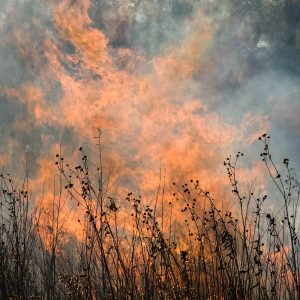 Alt, Jane Fulton (1951 – ), The Burn No. 74, 2009, archival inkjet print. Middlebury College Museum of Art. Purchase with funds provided by the Fine Arts Acquisition Fund, 2016.83. Alt, Jane Fulton (1951 – ), The Burn No. 74, 2009, archival inkjet print. Middlebury College Museum of Art. Purchase with funds provided by the Fine Arts Acquisition Fund, 2016.83. |
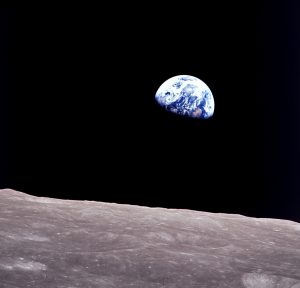 Anders, Wiliam (1933 – ), Earthrise, Apollo 8, December 24, 1968, archival digital print. Private collection. Courtesy NASA Anders, Wiliam (1933 – ), Earthrise, Apollo 8, December 24, 1968, archival digital print. Private collection. Courtesy NASA |
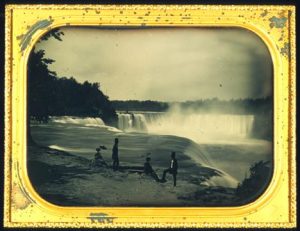 Babbitt, Platt D. (1823-1879), Niagara Falls, c. 1854, daguerreotype. Middlebury College Museum of Art. Purchase with funds provided by the Walter Cerf Art Fund, 2005.055. Babbitt, Platt D. (1823-1879), Niagara Falls, c. 1854, daguerreotype. Middlebury College Museum of Art. Purchase with funds provided by the Walter Cerf Art Fund, 2005.055. |
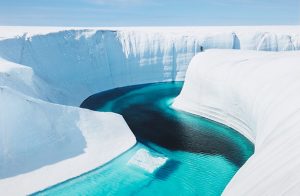 Balog, James (1952 – ), Greenland Ice Sheet, 28 June 2009, Adam LeWinter surveys Birthday Canyon, 2009, chromogenic color print. Middlebury College Museum of Art. Purchase with funds provided by the Fine Arts Acquisition Fund, 2015.006 Balog, James (1952 – ), Greenland Ice Sheet, 28 June 2009, Adam LeWinter surveys Birthday Canyon, 2009, chromogenic color print. Middlebury College Museum of Art. Purchase with funds provided by the Fine Arts Acquisition Fund, 2015.006 |
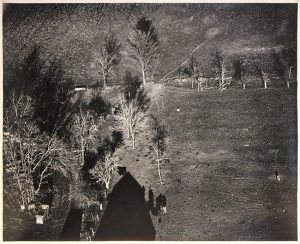 Bridges, Marilyn (1948 – ), Barn Shadow, 1981, gelatin silver print. Middlebury College Museum of Art. Gift of an anonymous donor, 2014.078. Copyright Marilyn Bridges. All rights reserved. Bridges, Marilyn (1948 – ), Barn Shadow, 1981, gelatin silver print. Middlebury College Museum of Art. Gift of an anonymous donor, 2014.078. Copyright Marilyn Bridges. All rights reserved.
|
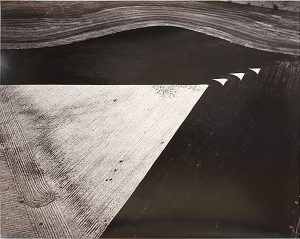 Bridges, Marilyn (1948 – ), Geometries, Lone Wolf, Oklahoma, 1987, gelatin silver print. Middlebury College Museum of Art. Gift of an anonymous donor, 2014.060. Copyright Marilyn Bridges. All rights reserved. Bridges, Marilyn (1948 – ), Geometries, Lone Wolf, Oklahoma, 1987, gelatin silver print. Middlebury College Museum of Art. Gift of an anonymous donor, 2014.060. Copyright Marilyn Bridges. All rights reserved. |
 Bridges, Marilyn (1948 – ), Mohave, CA, 1986, gelatin silver print. Middlebury College Museum of Art, gift of an anonymous donor, 2014.059. Copyright Marilyn Bridges. All rights reserved. Bridges, Marilyn (1948 – ), Mohave, CA, 1986, gelatin silver print. Middlebury College Museum of Art, gift of an anonymous donor, 2014.059. Copyright Marilyn Bridges. All rights reserved. |
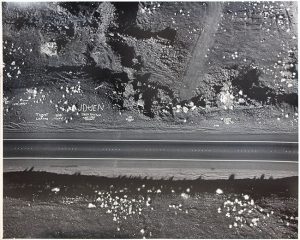 Bridges, Marilyn (1948 – ), Tom Loves Mary, Coral Graffiti, Hawaii, 1990, gelatin silver print. Middlebury College Museum of Art. Gift of an anonymous donor. 2014.065. Copyright Marilyn Bridges. All rights reserved. Bridges, Marilyn (1948 – ), Tom Loves Mary, Coral Graffiti, Hawaii, 1990, gelatin silver print. Middlebury College Museum of Art. Gift of an anonymous donor. 2014.065. Copyright Marilyn Bridges. All rights reserved. |
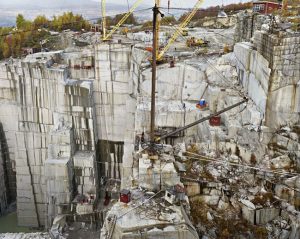 Burtynsky, Edward (1955 – ), Rock of Ages No. 19, Granite Section, Rock of Ages Quarry, Barre, Vermont, 1991, chromogenic color print. Middlebury College Museum of Art. Purchase with funds provided by the Walter Cerf Art Fund, 2008.034. Burtynsky, Edward (1955 – ), Rock of Ages No. 19, Granite Section, Rock of Ages Quarry, Barre, Vermont, 1991, chromogenic color print. Middlebury College Museum of Art. Purchase with funds provided by the Walter Cerf Art Fund, 2008.034. |
 Cherney, Michael (秋麥) (1969 – ), Pan Zhi Hua from Ten Thousand Li of the Yangtze River, 2015, handscroll, ink on mica flecked xuan paper. Middlebury College Museum of Art. Purchase with funds provided by the Christian A. Johnson Memorial Art Acquisition Fund, 2015.017. Cherney, Michael (秋麥) (1969 – ), Pan Zhi Hua from Ten Thousand Li of the Yangtze River, 2015, handscroll, ink on mica flecked xuan paper. Middlebury College Museum of Art. Purchase with funds provided by the Christian A. Johnson Memorial Art Acquisition Fund, 2015.017. |
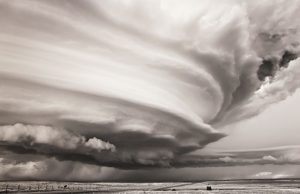 Dobrowner, Mitch (1956 – ), Chromosphere, Green Grass, South Dakota, 2012, archival pigment print. Middlebury College Museum of Art. Purchase with funds provided by the Fine Arts Acquisition Fund, 2015.229. Dobrowner, Mitch (1956 – ), Chromosphere, Green Grass, South Dakota, 2012, archival pigment print. Middlebury College Museum of Art. Purchase with funds provided by the Fine Arts Acquisition Fund, 2015.229. |
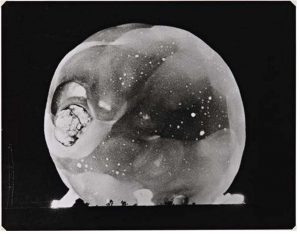 Edgerton, Harold (1903 – 1990), Atomic Bomb Explosion, 1952, gelatin silver print. Middlebury College Museum of Art. Gift of Robert F. Young. 1988.111. © 2010 MIT. Courtesy of MIT Museum Edgerton, Harold (1903 – 1990), Atomic Bomb Explosion, 1952, gelatin silver print. Middlebury College Museum of Art. Gift of Robert F. Young. 1988.111. © 2010 MIT. Courtesy of MIT Museum |
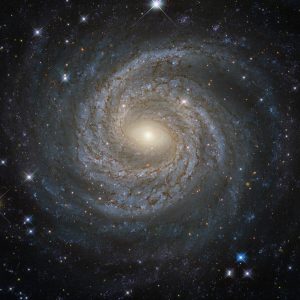 ESA/Hubble and NASA, acknowledgement Judy Schmidt, Spiral Galaxy NGC 6814. Hubble Space Telescope, 2016, archival digital print. Private collection. Courtesy NASA ESA/Hubble and NASA, acknowledgement Judy Schmidt, Spiral Galaxy NGC 6814. Hubble Space Telescope, 2016, archival digital print. Private collection. Courtesy NASA |
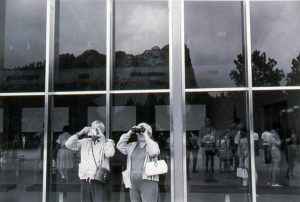 Friedlander, Lee (1934 – ), Mt. Rushmore, South Dakota, 1969, gelatin silver print. Middlebury College Museum of Art. Purchase with funds provided by the Memorial Art Fund, 1998.028. © Lee Friedlander, courtesy Fraenkel Gallery, San Francisco Friedlander, Lee (1934 – ), Mt. Rushmore, South Dakota, 1969, gelatin silver print. Middlebury College Museum of Art. Purchase with funds provided by the Memorial Art Fund, 1998.028. © Lee Friedlander, courtesy Fraenkel Gallery, San Francisco |
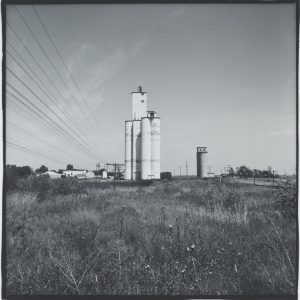 Gohlke, Frank (1942 – ), Grain Elevator, Hutchinson, Kansas, 1973, printed 1974, gelatin silver print. Middlebury Museum of Art. Purchase with funds provided by the Fine Arts Acquisition Fund, 2011.011. Gohlke, Frank (1942 – ), Grain Elevator, Hutchinson, Kansas, 1973, printed 1974, gelatin silver print. Middlebury Museum of Art. Purchase with funds provided by the Fine Arts Acquisition Fund, 2011.011. |
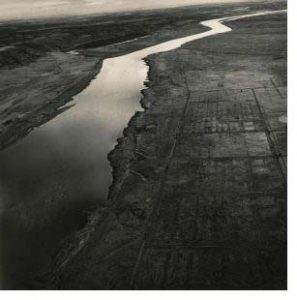 Gowin, Emmet (1941 – ), Old Hanford City Site and the Columbia River, Hanford Nuclear Reservation, near Richland, Washington, 1986, toned gelatin silver print. Hood Museum of Art, Dartmouth College, Hanover, New Hampshire. Purchased through a gift by exchange from Mr. and Mrs. Joseph H. Hazen, 20015.17.9. ©Emmet Gowin; courtesy Pace/MacGill Gallery, New York. Gowin, Emmet (1941 – ), Old Hanford City Site and the Columbia River, Hanford Nuclear Reservation, near Richland, Washington, 1986, toned gelatin silver print. Hood Museum of Art, Dartmouth College, Hanover, New Hampshire. Purchased through a gift by exchange from Mr. and Mrs. Joseph H. Hazen, 20015.17.9. ©Emmet Gowin; courtesy Pace/MacGill Gallery, New York. |
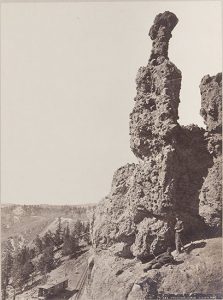 Jackson, William Henry (1843 – 1942, Phantom Curve, c. 1881-82, albumen print. Middlebury College Museum ofArt. Gift of Mr. and Mrs. Frederick W. Lapham III, 1984.043. Jackson, William Henry (1843 – 1942, Phantom Curve, c. 1881-82, albumen print. Middlebury College Museum ofArt. Gift of Mr. and Mrs. Frederick W. Lapham III, 1984.043. |
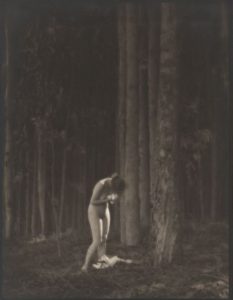 Kales, Arthur F. (1882-1936), Nude in Forest, c. 1914, gelatin silver print. Middlebury College Museum of Art. Gift of an anonymous donor and the Christian A. Johnson Memorial Fund, 1988. 012. Kales, Arthur F. (1882-1936), Nude in Forest, c. 1914, gelatin silver print. Middlebury College Museum of Art. Gift of an anonymous donor and the Christian A. Johnson Memorial Fund, 1988. 012. |
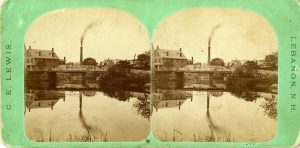 Lewis, C.E., Lebanon, N.H., c. 1881, stereograph. Private Collection. Lewis, C.E., Lebanon, N.H., c. 1881, stereograph. Private Collection. |
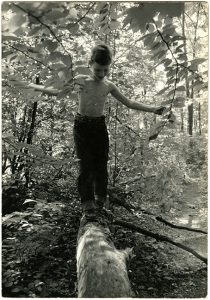 Lowe, Jacques (1930-2001), untitled, c. 1960, gelatin silver print. Middlebury College Museum of Art. Gift of Dr. and Mrs. Stephen Nicholas, 2015.130. Lowe, Jacques (1930-2001), untitled, c. 1960, gelatin silver print. Middlebury College Museum of Art. Gift of Dr. and Mrs. Stephen Nicholas, 2015.130. |
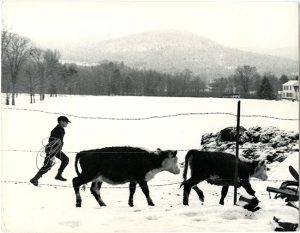 Lowe, Jacques (1930-2001), untitled, c. 1960, gelatin silver print. Middlebury College Museum of Art. Gift of Dr. and Mrs. Stephen Nicholas, 2015.130. Lowe, Jacques (1930-2001), untitled, c. 1960, gelatin silver print. Middlebury College Museum of Art. Gift of Dr. and Mrs. Stephen Nicholas, 2015.130. |
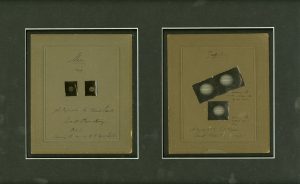 Lowell, Percival (1855 – 1916), Mars, 1909, and E.C. Slipher (1883 – 1964), Jupiter, 1909, gelatin silver prints. Middlebury College, Davis Family Library, Special Collections. Lowell, Percival (1855 – 1916), Mars, 1909, and E.C. Slipher (1883 – 1964), Jupiter, 1909, gelatin silver prints. Middlebury College, Davis Family Library, Special Collections. |
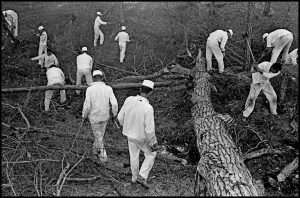
Lyon, Danny (1942 – ), Clearing Land, Ellis Unit, Texas, from the series Conversations with the Dead, 1968, gelatin silver print. Middlebury College Museum of Art. Gift of Carl W. Melcher, M.D., 1983.036. © Danny Lyon/Magnum Photos |
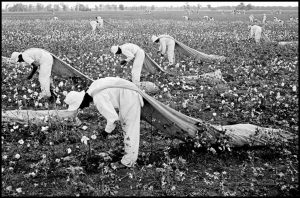 Lyon, Danny (1942 – ), Cotton Pickers, Ferguson Unit, Texas, from Conversations with the Dead, 1968, gelatin silver print. Middlebury College Museum of Art. Gift of Carl W. Melcher, M.D., 1983.035. © Danny Lyon/Magnum Photos Lyon, Danny (1942 – ), Cotton Pickers, Ferguson Unit, Texas, from Conversations with the Dead, 1968, gelatin silver print. Middlebury College Museum of Art. Gift of Carl W. Melcher, M.D., 1983.035. © Danny Lyon/Magnum Photos |
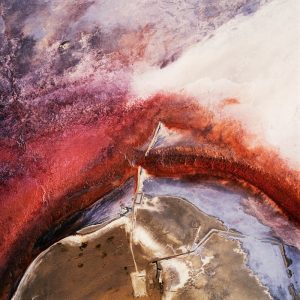 Maisel, David (1961 – ), The Lake Project 19, 2002, archival pigment print. Middlebury College Museum of Art. Purchase with funds provided by the Fine Arts Acquisition Fund, 2016.082. Maisel, David (1961 – ), The Lake Project 19, 2002, archival pigment print. Middlebury College Museum of Art. Purchase with funds provided by the Fine Arts Acquisition Fund, 2016.082. |
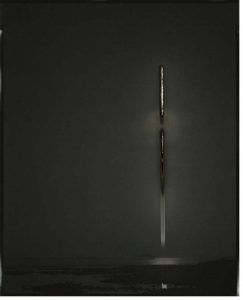 McCaw, Chris (1971 – ), Sunburned GSP#539 (Galapagos), 2012, unique gelatin silver paper negative. Middlebury College Museum of Art. Purchase with funds provided by the Foster Family Art Acquisition Fund, 2012.033. McCaw, Chris (1971 – ), Sunburned GSP#539 (Galapagos), 2012, unique gelatin silver paper negative. Middlebury College Museum of Art. Purchase with funds provided by the Foster Family Art Acquisition Fund, 2012.033. |
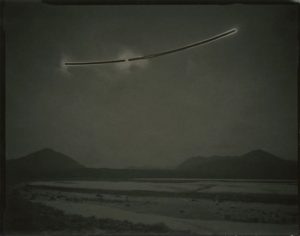 McCaw, Chris (1971 – ), Sunburned GSP #423 (Arctic Circle, Alaska), 2010, unique gelatin silver paper negative. Middlebury College Museum of Art. Purchase with funds provided by the Foster Family Art Acquisition Fund, 2012.032. McCaw, Chris (1971 – ), Sunburned GSP #423 (Arctic Circle, Alaska), 2010, unique gelatin silver paper negative. Middlebury College Museum of Art. Purchase with funds provided by the Foster Family Art Acquisition Fund, 2012.032. |
 Meyerowitz, Joel (1938 – ), Bay Sky Storm, 1987, chromogenic contact print. Middlebury College Museum of Art. Gift of Dr. and Mrs. Stephen Nichols, 2014.118. Meyerowitz, Joel (1938 – ), Bay Sky Storm, 1987, chromogenic contact print. Middlebury College Museum of Art. Gift of Dr. and Mrs. Stephen Nichols, 2014.118. |
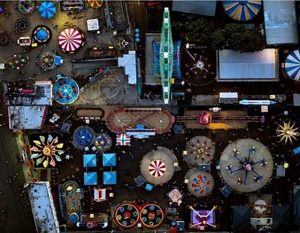 Milstein, Jeffrey, Coney Island, 2015, archival pigment print. Middlebury College Museum of Art. Milstein, Jeffrey, Coney Island, 2015, archival pigment print. Middlebury College Museum of Art. |
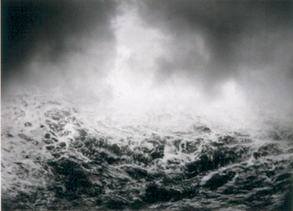 Ming, Dodo Jin (1955 – ), Free Element, Plate XXXI, 2002, gelatin silver print. Middlebury College Museum of Art. Purchase with funds provided by the Christian A. Johnson Memorial Art Acquisition Fund, 2005.035. Ming, Dodo Jin (1955 – ), Free Element, Plate XXXI, 2002, gelatin silver print. Middlebury College Museum of Art. Purchase with funds provided by the Christian A. Johnson Memorial Art Acquisition Fund, 2005.035. |
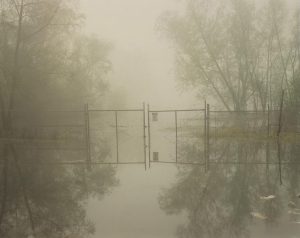 Misrach, Richard (1949 – ), Hazardous Waste Containment Site, Dow Chemical Corp, 1998, 1998/2001, chromogenic color print. Middlebury College Museum of Art. Purchase with funds provided by the Contemporary Photography, Film, and Video Acquisition Fund, 2004.026. Misrach, Richard (1949 – ), Hazardous Waste Containment Site, Dow Chemical Corp, 1998, 1998/2001, chromogenic color print. Middlebury College Museum of Art. Purchase with funds provided by the Contemporary Photography, Film, and Video Acquisition Fund, 2004.026. |
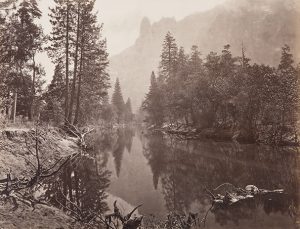 Muybridge, Eadweard (1830-1904), Loya, Valley of Yosemite, c. 1872, albumen print. Middlebury College Museum of Art. Purchase with funds provided by the Friends of Art Acquisition Fund, 1998.030. Muybridge, Eadweard (1830-1904), Loya, Valley of Yosemite, c. 1872, albumen print. Middlebury College Museum of Art. Purchase with funds provided by the Friends of Art Acquisition Fund, 1998.030. |
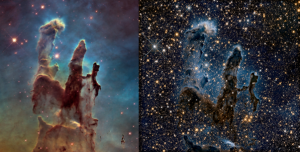 NASA, ESA, and the Hubble Heritage Team (STScI/AURA), Hubble WFC/UVIS Image of M16/ The Eagle Nebula, 2014 and NASA, ESA, and the Hubble Heritage Team (STScI/AURA), A Near-Infrared View of the Pillars of Creation, Hubble Space Telescope, 2015, archival digital prints. Private collection. Courtesy NASA NASA, ESA, and the Hubble Heritage Team (STScI/AURA), Hubble WFC/UVIS Image of M16/ The Eagle Nebula, 2014 and NASA, ESA, and the Hubble Heritage Team (STScI/AURA), A Near-Infrared View of the Pillars of Creation, Hubble Space Telescope, 2015, archival digital prints. Private collection. Courtesy NASA |
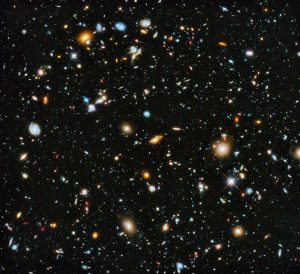 NASA, ESA, H. Teplitz and M. Rafelski (IPAC/Caltech), A Koekemoer (STScI), R. Windhorst (ASU), Z. Levay (STScI), Hubble Ultra Deep Field, 2014, archival digital print. Private collection. Courtesy NASA NASA, ESA, H. Teplitz and M. Rafelski (IPAC/Caltech), A Koekemoer (STScI), R. Windhorst (ASU), Z. Levay (STScI), Hubble Ultra Deep Field, 2014, archival digital print. Private collection. Courtesy NASA |
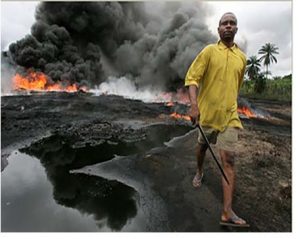 Osodi, George (1974 – ), Oil Spill Near Farm Land Ogoni, 2007, digital ink print. Middlebury College Museum of Art. Purchase with funds provided by the Foster Family Art Acquisition Fund. 2012.028. By permission of George Osodi c/o Z Photographic Ltd. Osodi, George (1974 – ), Oil Spill Near Farm Land Ogoni, 2007, digital ink print. Middlebury College Museum of Art. Purchase with funds provided by the Foster Family Art Acquisition Fund. 2012.028. By permission of George Osodi c/o Z Photographic Ltd. |
 O’Sullivan, Timothy (1840-1882), The Old Trapper, 1869, albumen print. Middlebury College Museum of Art. Gift of the Friends of Art, 1987.045. O’Sullivan, Timothy (1840-1882), The Old Trapper, 1869, albumen print. Middlebury College Museum of Art. Gift of the Friends of Art, 1987.045. |
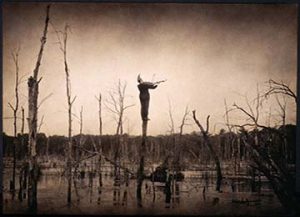 ParkeHarrison, Robert and Shana (1968, 1964 – ), Tree Sonata, 1999, gelatin silver print on resin-coated paper, mounted on wood panel with acrylics and varnish. Middlebury College Museum of Art. Purchase with funds provided by the Friends of Art Acquisition Fund and the Memorial Art Fund, 2013.020. ParkeHarrison, Robert and Shana (1968, 1964 – ), Tree Sonata, 1999, gelatin silver print on resin-coated paper, mounted on wood panel with acrylics and varnish. Middlebury College Museum of Art. Purchase with funds provided by the Friends of Art Acquisition Fund and the Memorial Art Fund, 2013.020. |
 Pfahl, John (1939 – ), Trojan Nuclear Plant, Columbia River, Oregon, October 1982/printed 2014, pigment print on Platine Paper. Middlebury College Museum of Art. Purchase with funds provided by the Fine Arts Acquisition Fund, 2015.018. Pfahl, John (1939 – ), Trojan Nuclear Plant, Columbia River, Oregon, October 1982/printed 2014, pigment print on Platine Paper. Middlebury College Museum of Art. Purchase with funds provided by the Fine Arts Acquisition Fund, 2015.018. |
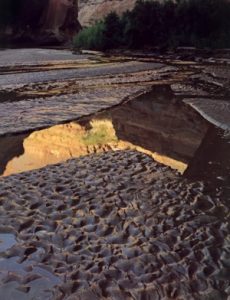 Porter, Eliot (1901-1990), Escalante River Outwash, Glen Canyon, September 2, 1962, dye transfer Print, 1980. Middlebury College Museum of Art. Gift of Jeremy Dworkin ’62 and B.D. Dworkin, 2013.023.07. © 1990 Amon Carter Museum of American Art, Fort Worth, Texas Porter, Eliot (1901-1990), Escalante River Outwash, Glen Canyon, September 2, 1962, dye transfer Print, 1980. Middlebury College Museum of Art. Gift of Jeremy Dworkin ’62 and B.D. Dworkin, 2013.023.07. © 1990 Amon Carter Museum of American Art, Fort Worth, Texas |
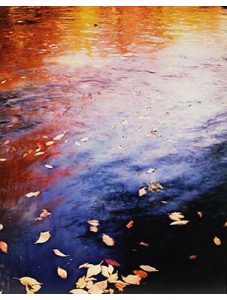 Porter, Eliot (1901-1990), Pool in a brook, Pond Brook, Near Whiteface, New Hampshire, 1953, dye transfer print. Middlebury College Museum of Art. Gift of Jeremy Dworkin ’62 and B. D. Dworkin, South Londonderry, Vermont, 2012.031.09. © 1990 Amon Carter Museum of American Art, Fort Worth, Texas Porter, Eliot (1901-1990), Pool in a brook, Pond Brook, Near Whiteface, New Hampshire, 1953, dye transfer print. Middlebury College Museum of Art. Gift of Jeremy Dworkin ’62 and B. D. Dworkin, South Londonderry, Vermont, 2012.031.09. © 1990 Amon Carter Museum of American Art, Fort Worth, Texas |
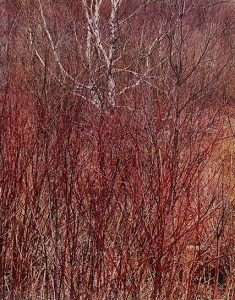 Porter, Eliot (1901-1990), Red Osier, Near Great Barrington, Massachusetts, 1957, dye transfer print. Middlebury College Museum of Art. Gift of Jeremy Dworkin ’62 and B. D. Dworkin, South Londonderry, Vermont. 2012.031.01. © 1990 Amon Carter Museum of American Art, Fort Worth, Texas Porter, Eliot (1901-1990), Red Osier, Near Great Barrington, Massachusetts, 1957, dye transfer print. Middlebury College Museum of Art. Gift of Jeremy Dworkin ’62 and B. D. Dworkin, South Londonderry, Vermont. 2012.031.01. © 1990 Amon Carter Museum of American Art, Fort Worth, Texas |
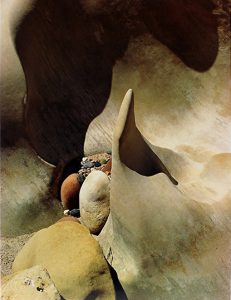 Porter, Eliot (1901-1990), Sculpted Rock, Marble Canyon, Arizona, 967, from the portfolio In Wildness, 1981, dye transfer print. Middlebury College Museum of Art. Gift of Jeremy Dworkin ’62 and B. D. Dworkin, South Londonderry, Vermont, 2012..031.07. © 1990 Amon Carter Museum of American Art, Fort Worth, Texas Porter, Eliot (1901-1990), Sculpted Rock, Marble Canyon, Arizona, 967, from the portfolio In Wildness, 1981, dye transfer print. Middlebury College Museum of Art. Gift of Jeremy Dworkin ’62 and B. D. Dworkin, South Londonderry, Vermont, 2012..031.07. © 1990 Amon Carter Museum of American Art, Fort Worth, Texas |
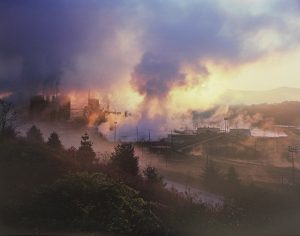 Rich, Jeff (1977 – ), Blue Ridge Paper Mill, Pigeon River, Canton, North Carolina, 2008, archival pigment print. Middlebury College Museum of Art. Purchase with funds provided by the Fine Arts Acquisition Fund, 2015.230. Rich, Jeff (1977 – ), Blue Ridge Paper Mill, Pigeon River, Canton, North Carolina, 2008, archival pigment print. Middlebury College Museum of Art. Purchase with funds provided by the Fine Arts Acquisition Fund, 2015.230. |
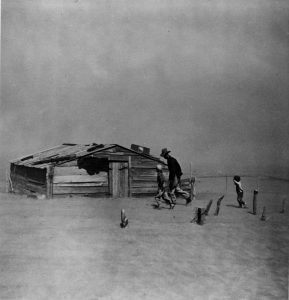 Rothstein, Arthur (1915 – 1985), Dust Storm, Cimarron County, Oklahoma, April 1936, gelatin silver print. Collection of Middlebury College Museum of Art, gift of George R. Rinhart, 1996.003. Rothstein, Arthur (1915 – 1985), Dust Storm, Cimarron County, Oklahoma, April 1936, gelatin silver print. Collection of Middlebury College Museum of Art, gift of George R. Rinhart, 1996.003. |
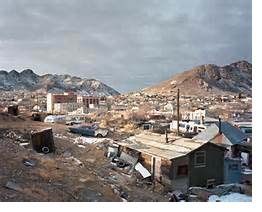 Schutmaat, Bryan (1983 – ), Tonopah, Nevada, 2012, archival digital print. Middlebury College Museum of Art. Schutmaat, Bryan (1983 – ), Tonopah, Nevada, 2012, archival digital print. Middlebury College Museum of Art. |
 Shore, Stephen (1947 – ), North Black Avenue, Bozeman, 1981, dye transfer print. Middlebury College Museum of Art. Gift of Ted Perry, 1987.033. Shore, Stephen (1947 – ), North Black Avenue, Bozeman, 1981, dye transfer print. Middlebury College Museum of Art. Gift of Ted Perry, 1987.033. |
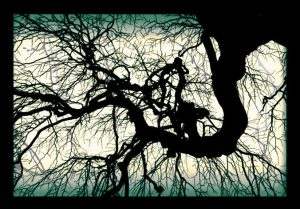 Starn, Mike and Doug (1961 – ), Structure of Thought 30, archival digital print with vellum overlay. 2001-2006/2016. Private collection. Starn, Mike and Doug (1961 – ), Structure of Thought 30, archival digital print with vellum overlay. 2001-2006/2016. Private collection. |
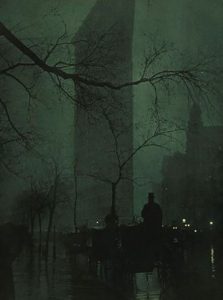 Steichen, Edward (1879 – 1973), The Flatiron—Evening from Camera Work XIV, 1904, published 1906, tritone on paper. Middlebury College Museum of Art. Purchase with funds provided by the Walter Cerf Art Fund, 2008.026. Steichen, Edward (1879 – 1973), The Flatiron—Evening from Camera Work XIV, 1904, published 1906, tritone on paper. Middlebury College Museum of Art. Purchase with funds provided by the Walter Cerf Art Fund, 2008.026. |
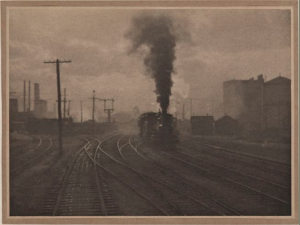 Stieglitz, Alfred (1864-1946), The Hand of Man, 1902, photogravure printed on Japanese paper and included in Camera Work magazine, 1903. Middlebury College Museum of Art. Purchase with funds provided by the Fine Arts Acquisition Fund, 2004.045. Stieglitz, Alfred (1864-1946), The Hand of Man, 1902, photogravure printed on Japanese paper and included in Camera Work magazine, 1903. Middlebury College Museum of Art. Purchase with funds provided by the Fine Arts Acquisition Fund, 2004.045. |
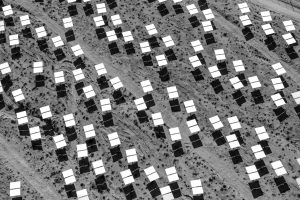 Stillings, Jamey (1955 – ), #6425 2 June 2012 from The Evolution of Ivanpah Solar, archival pigment print. Middlebury College Museum of Art. Gift of Bread Loaf Corporation, Architects, Planners, Builders. 2013.010. Stillings, Jamey (1955 – ), #6425 2 June 2012 from The Evolution of Ivanpah Solar, archival pigment print. Middlebury College Museum of Art. Gift of Bread Loaf Corporation, Architects, Planners, Builders. 2013.010. |
 Strand, Paul (1890-1976), White Fence, Port Kent, New York, 1916, photogravure, published in Camera Work, 1917. Middlebury College Museum of Art. Purchase with funds provided by the Walter Cerf Art Fund, 2008.031. © Aperture Foundation, Inc., Paul Strand Archive Strand, Paul (1890-1976), White Fence, Port Kent, New York, 1916, photogravure, published in Camera Work, 1917. Middlebury College Museum of Art. Purchase with funds provided by the Walter Cerf Art Fund, 2008.031. © Aperture Foundation, Inc., Paul Strand Archive |
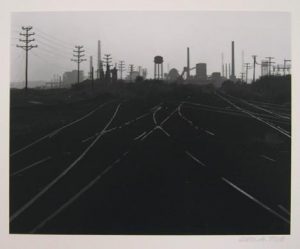 Tice, George A. (1938 – ), Industrial Landscape, Kearney, N.J., 1979, gelatin silver print. Middlebury College Museum of Art. Purchase with funds provided by a matching grant from the National Endowment for the Arts, 1981.107. Tice, George A. (1938 – ), Industrial Landscape, Kearney, N.J., 1979, gelatin silver print. Middlebury College Museum of Art. Purchase with funds provided by a matching grant from the National Endowment for the Arts, 1981.107. |
 Uelsmann, Jerry (1934 – ), untitled, 1976, gelatin silver print. Middlebury College Museum of Art. Purchase with funds provided by the Electra Havemeyer Webb Memorial Fund, 2003.022. Uelsmann, Jerry (1934 – ), untitled, 1976, gelatin silver print. Middlebury College Museum of Art. Purchase with funds provided by the Electra Havemeyer Webb Memorial Fund, 2003.022. |
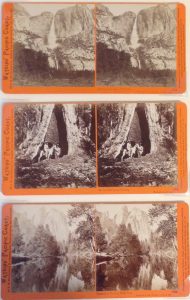 Watkins, Carleton (1829-1916), Yosemite Falls, 2630 feet; In the Mariposa Grove; Cathedral Rocks, 2600 feet, from Watkins Pacific Coast stereographs, c. 1871-75, albumen prints from wet-collodion negatives. Private collection. Watkins, Carleton (1829-1916), Yosemite Falls, 2630 feet; In the Mariposa Grove; Cathedral Rocks, 2600 feet, from Watkins Pacific Coast stereographs, c. 1871-75, albumen prints from wet-collodion negatives. Private collection. |
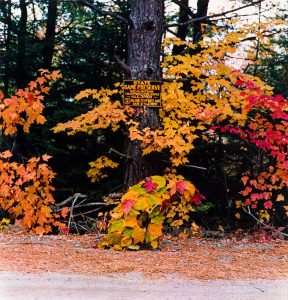 Wegman, William (1943 – ), October 1981, Rangeley, Maine, 1981, dye transfer print. Middlebury College Museum of Art. Gift of Mr. and Mrs. Ted Perry, 1984.024. Courtesy William Wegman Wegman, William (1943 – ), October 1981, Rangeley, Maine, 1981, dye transfer print. Middlebury College Museum of Art. Gift of Mr. and Mrs. Ted Perry, 1984.024. Courtesy William Wegman |
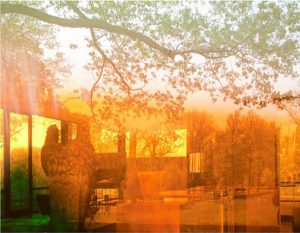 Welling, James (1951 – ), 6236, 2008, inkjet print. Middlebury College Museum of Art. Purchase with funds provided by the Christian A. Johnson Memorial Art Acquisition Fund, 2011.002. © James Welling. Courtesy the artist and David Zwirner, New York/London. Philip Johnson Glass House is a site of the National Trust for Historic Preservation Welling, James (1951 – ), 6236, 2008, inkjet print. Middlebury College Museum of Art. Purchase with funds provided by the Christian A. Johnson Memorial Art Acquisition Fund, 2011.002. © James Welling. Courtesy the artist and David Zwirner, New York/London. Philip Johnson Glass House is a site of the National Trust for Historic Preservation |
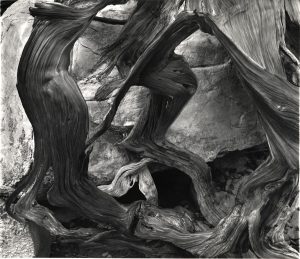 Weston, Brett (1911-1993), Bristlecone Pine, California, 1976, gelatin silver print. Middlebury Museum of Art. Gift from the Christian Keesee Collection, 2016.033. Weston, Brett (1911-1993), Bristlecone Pine, California, 1976, gelatin silver print. Middlebury Museum of Art. Gift from the Christian Keesee Collection, 2016.033. |
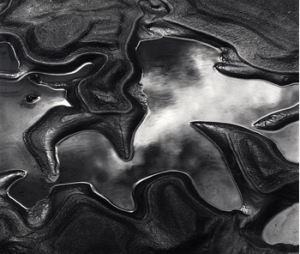 Weston, Brett (1911-1993), Glacial Silt, 1973, gelatin silver print. Middlebury College Museum of Art. Gift from the Christian Keesee Collection, 2016.064. Weston, Brett (1911-1993), Glacial Silt, 1973, gelatin silver print. Middlebury College Museum of Art. Gift from the Christian Keesee Collection, 2016.064. |
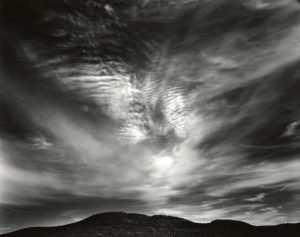 Weston, Brett (1911-1993), Mountains and Clouds, New Mexico, c. 1940, gelatin silver print. Middlebury College Museum of Art. Gift from the Christian Keesee Collection, 2016.041. Weston, Brett (1911-1993), Mountains and Clouds, New Mexico, c. 1940, gelatin silver print. Middlebury College Museum of Art. Gift from the Christian Keesee Collection, 2016.041. |
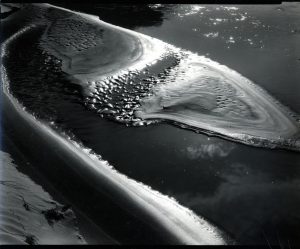 Weston, Brett (1911-1993), Sandbar, Glen Canyon, Utah, 1960, gelatin silver print. Middlebury College Museum of Art. Gift from the Christian Keesee Collection, 2016.049. Weston, Brett (1911-1993), Sandbar, Glen Canyon, Utah, 1960, gelatin silver print. Middlebury College Museum of Art. Gift from the Christian Keesee Collection, 2016.049. |
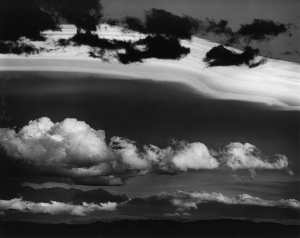 Weston, Brett (1911-1993), Untitled (Desert Clouds), 1976, gelatin silver print. Middlebury College Museum of Art. Gift from the Christian Keesee Collection, 2016.073. Weston, Brett (1911-1993), Untitled (Desert Clouds), 1976, gelatin silver print. Middlebury College Museum of Art. Gift from the Christian Keesee Collection, 2016.073. |
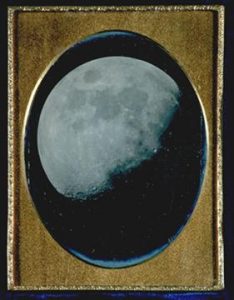 Whipple, John Adams (1823 – 1891), The Moon, 6 August 1851, daguerreotype. Middlebury College Museum of Art. Purchase with funds provided by the Christian A. Johnson Memorial Fund and the Overbrook Foundation, 1989.009. Whipple, John Adams (1823 – 1891), The Moon, 6 August 1851, daguerreotype. Middlebury College Museum of Art. Purchase with funds provided by the Christian A. Johnson Memorial Fund and the Overbrook Foundation, 1989.009. |
White, Clarence (1871-1925), The Orchard, from Camera Work IX, 1902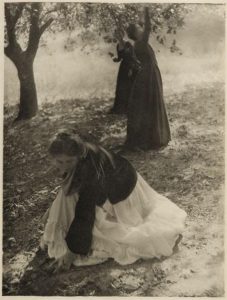 , published 1905, photogravure. Middlebury College Museum of Art. Purchase with funds provided by the Walter Cerf Art Fund. 2008.022. , published 1905, photogravure. Middlebury College Museum of Art. Purchase with funds provided by the Walter Cerf Art Fund. 2008.022. |
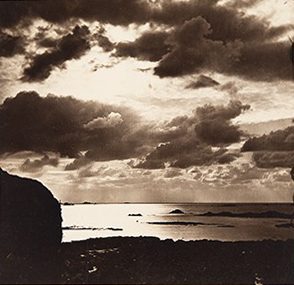 Wortley, Colonel Henry Stuart (1832-1890), View of Water and Sky, c. 1869, albumen print. Middlebury College Museum of Art. Purchase with funds provided by the Fine Arts Acquisition Fund. 2004.043. Wortley, Colonel Henry Stuart (1832-1890), View of Water and Sky, c. 1869, albumen print. Middlebury College Museum of Art. Purchase with funds provided by the Fine Arts Acquisition Fund. 2004.043. |


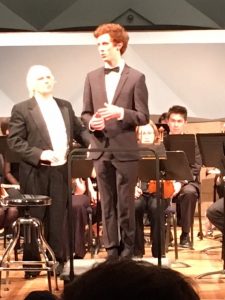
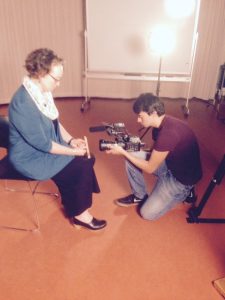

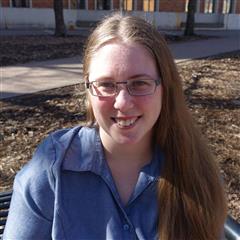
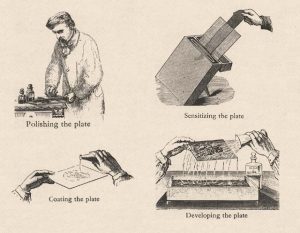 In 1851, Frederick Scott Archer invented a new photographic process to replace one-of-a-kind daguerreotypes on metal that were popular for portraits and multiple but imprecise calotypes made from paper negatives. The new process produced a clear negative on transparent glass that could be used to print multiple prints on paper. As its name implies, exposure and development of the negative had to be done within a ten-minute time frame while the light sensitive chemicals were wet, requiring photographers to bring portable darkrooms into the field. Although the process was capable of rendering fine detail within the shadows, the chemicals were sensitive only to blue light, making it impossible to render cloud-filled skies without exposing a separate negative only for the clouds. Because practical techniques for enlarging were not yet available, the glass negatives had to be the size of the finished print.
In 1851, Frederick Scott Archer invented a new photographic process to replace one-of-a-kind daguerreotypes on metal that were popular for portraits and multiple but imprecise calotypes made from paper negatives. The new process produced a clear negative on transparent glass that could be used to print multiple prints on paper. As its name implies, exposure and development of the negative had to be done within a ten-minute time frame while the light sensitive chemicals were wet, requiring photographers to bring portable darkrooms into the field. Although the process was capable of rendering fine detail within the shadows, the chemicals were sensitive only to blue light, making it impossible to render cloud-filled skies without exposing a separate negative only for the clouds. Because practical techniques for enlarging were not yet available, the glass negatives had to be the size of the finished print.





































































